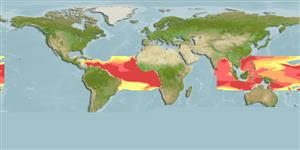Teleostei (teleosts) >
Argentiniformes (Marine smelts) >
Bathylagidae (Deep-sea smelts)
Etymology: Bathylagoides: Greek, bathys = deep + Greek, lagoides = similar to a hare (Ref. 45335).
More on author: Norman.
Environment: milieu / climate zone / depth range / distribution range
Ecology
Marine; bathypelagic; depth range 125 - ? m (Ref. 58018), usually 200 - 300 m (Ref. 33679). Deep-water; 23°N - 18°S
Indo-West Pacific: Indonesia (Ref. 5978). Also known in tropical Atlantic.
Size / Weight / Age
Maturity: Lm ? range ? - ? cm
Max length : 12.0 cm SL male/unsexed; (Ref. 126117); max. published weight: 11.60 g (Ref. 126117)
Dorsal soft rays (total): 12 - 13; Anal soft rays: 15 - 16. Deep body, evenly narrowed toward the end of caudal peduncle. Maximum depth slightly about level of pectoral fin base for 2.37-8.15 cm specimens. Caudal peduncle short and narrow. Pectorals short, not reaching origin of dorsal fin. Radial pattern on operculum present. Gill rakers on the inner surface of epibranchial of first gill arch (Ref. 33679).
Life cycle and mating behavior
Maturity | Reproduction | Spawning | Eggs | Fecundity | Larvae
Cohen, D.M., 1990. Bathylagidae. p. 239-240. In J.C. Quero, J.C. Hureau, C. Karrer, A. Post and L. Saldanha (eds.) Check-list of the fishes of the eastern tropical Atlantic (CLOFETA). JNICT, Lisbon; SEI, Paris; and UNESCO, Paris. Vol. 1. (Ref. 4459)
IUCN Red List Status (Ref. 130435: Version 2024-1)
Threat to humans
Harmless
Human uses
Tools
Special reports
Download XML
Internet sources
Estimates based on models
Preferred temperature (Ref.
123201): 11 - 20, mean 13.4 °C (based on 154 cells).
Phylogenetic diversity index (Ref.
82804): PD
50 = 0.6250 [Uniqueness, from 0.5 = low to 2.0 = high].
Bayesian length-weight: a=0.00575 (0.00281 - 0.01179), b=3.03 (2.85 - 3.21), in cm total length, based on LWR estimates for this species & (Sub)family-body (Ref.
93245).
Trophic level (Ref.
69278): 3.3 ±0.4 se; based on size and trophs of closest relatives
Resilience (Ref.
120179): Medium, minimum population doubling time 1.4 - 4.4 years (Preliminary K or Fecundity.).
Fishing Vulnerability (Ref.
59153): Low vulnerability (10 of 100).
